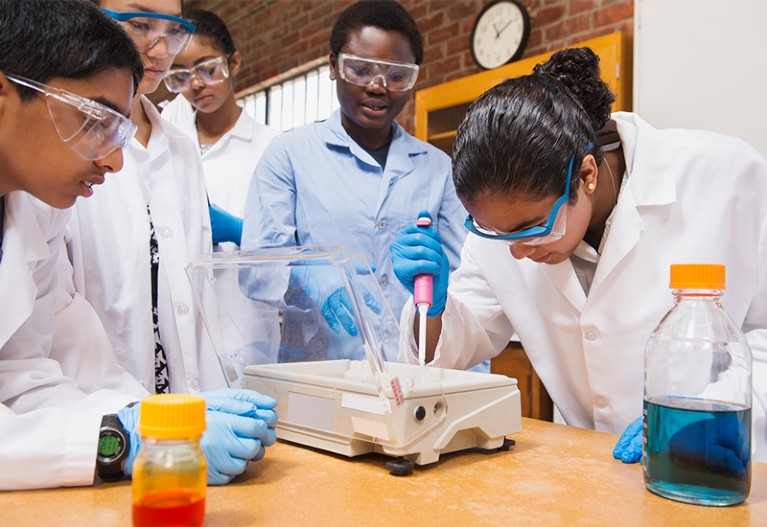
Broader trends are shaping the future movement of international students.Credit: Getty
The United States has reversed a pandemic-fuelled decline in student enrolment and remains the world’s leading host destination for international students, accepting 15% of the global total in 2021–22, a report finds.
In second place is the United Kingdom, which accepts 10% of all international students, followed by Canada at 9%, according to figures from the Institute of International Education (IIE), a non-profit organization based in New York City.
The IIE’s annual ‘Open Doors’ report shows a 3.8% increase to 948,519 international students enrolled in US institutions. In the 2020–21 academic year, at the height of the COVID-19 lockdowns, there were 914,095 international students studying in the United States, a 15% drop from the previous year (1,075,496).
Despite the rebound in the United States, there are broader trends shaping future movement of international students across the globe, according to specialists. For the past two decades, China, India and South Korea have been the top three countries from which students have chosen to study in the United States, says Krishna Bista, a higher-education researcher at Morgan State University in Baltimore, Maryland. However, there were 9% fewer students from China last year than in the 2020–21 academic year.
And, political tensions between the United States and China could further affect the number of scholars from China who wish to study in the United States, says Jenny Lee, who researches migration policies and geopolitics in higher education at the University of Arizona in Tucson. In the past five years, the US Department of Justice has stepped up efforts to prosecute individuals, notably of Chinese heritage, whom it suspects of being engaged in trade-secret theft and economic espionage.
That means anyone working or studying in the United States and engaging with China might fear they are being watched or that they might be falsely accused of violating intellectual-property laws, explains Lee.
Temporary blip?
Wei Liu, who studies global higher education at the University of Alberta International in Edmonton, Canada, speculates that the drop in US enrolments from China could be temporary. “Chinese pandemic policy created a huge psychological fear among Chinese parents about more-relaxed pandemic policies in the Western world,” Liu says. Still, the decline from China has remained steady over the past several years, says Chris Glass, who studies higher-education trends at Boston College in Massachusetts.
Overall student recruitment to the United States faces a host of broad factors, adds Lee. Those include uncertainties stemming from politics, notably the upcoming outcome of the 2024 US presidential election — which could again result in sudden visa bans and harsher immigration policies, as seen during the Trump presidency.
“Who wouldn’t feel angst putting an investment into the next four years without knowing what will happen in next two years?” she asks.
Students thinking of working and studying in the United States have also raised concerns about living costs, abortion bans and anti-Asian hate crimes. “Ultimately, it’s about the climate — the potential criminalization of Chinese graduate students and visiting scholars. That, to me, is the bigger issue that overrides COVID and even anti-Asian hate,” Lee says.
But, the IIE report identified positive trends in US universities’ recruitment efforts of international students. Student enrolment in US institutions was higher from only a few nations, notably India, whose numbers increased by 19% from 2020–21. The report also records an 80% increase in the number of first-year international students during autumn 2021 compared with autumn 2020. But Glass describes it as a return to the “relatively incremental growth” seen pre-pandemic.
Graduate boost
An increase in graduate students from abroad studying in the United States contributed the most to the US rebound. In 2021–22, their number rose by 17%.
International graduate students go to US institutions for particular areas of study, the report found: mathematics and computer science garnered 23% of enrolments for 2021–22, as did engineering. Another 11% of students chose physical and life sciences.
Bista says that the figures are the latest to reflect the fact that young scholars have wearied of remaining in their home nation to study.
But there are an increasing number of competitors to US universities. Glass notes that cost is one deciding factor. The United States “is incredibly expensive, and increasingly unaffordable”, he says. International students contributed US$32 billion to the US economy in 2021, according to the report, which cites data from the US Department of Commerce. More than 50% of students use personal or family funds to finance their education. Lee agrees that cost is a big factor, adding that it could explain the continued 4.2% decline at the undergraduate level in 2021–22.
Bista says that since the pandemic began in 2020, many international students have faced waits, sometimes of up to a full year, for visa interviews at US embassies and consulates — which delays their studies.
Many international students take advantage of optional practical training (OPT), the report says. The scheme allows students to extend their stay by up to 36 months to work for a US employer in their field of study if they have earnt a degree in certain areas of science, technology, engineering or maths. The number of OPT participants boosts student numbers, Glass says. “International student enrolment has been propped up by OPT since 2015.”
More specifically, the data in the report also highlight that higher education in the United States still has a lot of growth potential. International students represent 5% of total enrolment at US institutions, but they make up 25% at Canadian and Australian universities.
Glass says that more-streamlined federal immigration and labour policies, as well as more-welcoming rhetoric, would encourage international students to choose the United States. “We are not living up to our potential,” he says.

